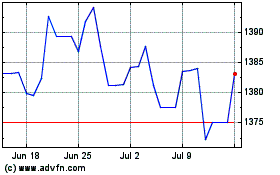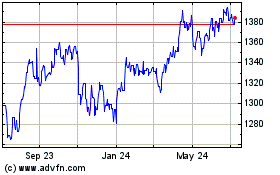Most Southeast Asian Currencies Plunge Against Dollar
October 09 2009 - 12:36AM
RTTF2
Friday in Asia, most Southeast Asian currencies plummeted
against the U.S. dollar despite a gain in most Asian stocks.
The Hong Kong and the Taiwan dollars slipped to 3-day low
against the US currency. Meanwhile, the currencies of India,
Philippine and South Korea fell from 1-year highs against the
dollar.
On the other hand, the Chinese yuan surged up to a 4-month high
against the dollar as the former was supported by China's Shangai
composite index, which jumped more than 3.5% today.
Federal Reserve Chairman Ben Bernanke reiterated Thursday that
low interest rates will likely remain in effect for the foreseeable
future.
"My colleagues at the Federal Reserve and I believe that
accommodative policies will likely be warranted for an extended
period," Bernanke said in remarks prepared for delivery to the
Federal Reserve Board Conference on Key Developments in Monetary
Policy in Washington, DC.
Bernanke said the Fed will begin tightening monetary policy
"when the economic outlook improves sufficiently." He added that
the timing and pace of any future tightening or use of other tools
will be done "to best foster our dual objectives of maximum
employment and price stability."
The Singapore dollar that closed yesterday's trading at 1.3891
against the U.S. currency fell to 1.3935 in early Asian deals on
Friday. The near term support for the Singapore currency is seen
around the 1.403 level.
During early Asian trading on Friday, the Hong Kong dollar
weakened to a 3-day low of 7.7510 against the U.S. currency. This
may be compared to Thursday's closing value of 7.7502. On the
downside, 7.7516 is seen as the next target level for the Hong Kong
dollar.
The Thai baht declined to 33.42 against the US dollar during
early Asian deals on Friday. The next downside target level for the
Thailand currency is seen at 33.48. At yesterday's close, the
dollar-baht pair was quoted at 33.33.
In early Asian deals on Friday, the Malaysian ringgit slipped to
3.4025 against the dollar. If the Malaysian currency weakens
further, it may likely target the 3.420 level. The dollar-ringgit
pair closed yesterday's North American session at 3.3775.
The Philippine peso that jumped to a 1-year high of 46.28
against the dollar at 6:45 pm ET Thursday weakened thereafter. The
peso thus dropped to 46.6950 per dollar by about 10:05 pm ET. The
next downside target level for the Philippine currency is seen at
46.735. The dollar-peso pair was worth 46.35 at yesterday's
close.
The Taiwan dollar, which closed yesterday's trading at 32.1650
against the U.S. currency slumped to a 3-day low of 32.3390 during
early Asian deals on Friday. On the downside, 32.295 is seen as the
next support level for the Taiwan dollar.
During early Asian deals on Friday, the Chinese yuan gained
against the dollar and reached a 4-month high of 6.8250 at 9:40 pm
ET. Although the yuan slipped thereafter, it rebounded shortly and
the pair is currently worth 6.8257. If the Chinese currency
advances further, it may target the 6.822 level.
The People's Bank of China has set today's central parity rate
for the dollar-yuan pair at 6.8270.
The South Korean won declined against the dollar after hitting a
new 1-year high of 1164.10 at 8:05 pm ET Thursday. The won dipped
to 1168.95 per dollar by about 8:15 pm ET and this may be compared
to yesterday's close of 1164.60. On the downside, 1169.5 is seen as
the next target level for the Korean currency.
The Indian rupee that soared to a new 1-year high of 46.07
against the US dollar at 8:25 pm ET Thursday edged down thereafter.
The rupee slipped to 46.45 per dollar by about 11:35 pm ET. If the
Indian currency drops further, it may target the 46.68 level. The
dollar-rupee pair closed yesterday's New York session at
46.3550.
Today, Thailand will release foreign reserves data for the week
ending October 2. Forecasts call for an increase of 132.8 percent
on year after the 132.3 percent annual jump in the previous
week.
Also, Philippines will provide August numbers for exports, with
analysts expecting a decline of 20 percent on year following the
25.4 percent annual contraction in July.
From the U.S., the trade balance report for August has been
slated for release in the North American session.
US Dollar vs KRW (FX:USDKRW)
Forex Chart
From Mar 2024 to Apr 2024

US Dollar vs KRW (FX:USDKRW)
Forex Chart
From Apr 2023 to Apr 2024
